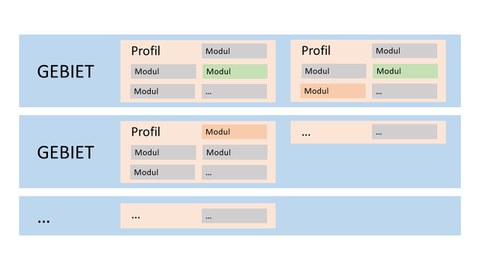Elective Area Business Administration and Economics

© Crispin-Iven Mokry

© Klaus Gigga

© Klaus Gigga
The compulsory elective area of Business Education and Management Training comprises 75 or 30 credit points, depending on the field of study, and thus offers extensive opportunities for in-depth study and specialization.
Table of contents
Basic structure

Grundstruktur Wahlpflichtbereich Wirtschaft
- The modules in the compulsory elective area are assigned to areas and profiles.
- The areas form the flexible basic structure of the compulsory elective area. Various soft point limits apply to them.
- With the profiles within the areas, you can set further accents in your study orientation.
Modules
The full range of compulsory elective modules can be found in the table Modules of the compulsory elective area on the Study Documents website.
There you can also see which areas and profiles the modules belong to. Some modules are represented in several areas and/or profiles at the same time due to their suitability in terms of content - see the modules highlighted in green or red in the diagram of the basic structure. They are then primarily assigned to the thematically closest profile and subordinate to one or more other profile(s).
You can find out what content and qualification objectives, forms of teaching and examinations the modules contain in the module handbook for business and the module handbook for qualification directions on the study documents website.
Areas
In the compulsory elective area of Business Education and Management Training of the Master's degree program, there are the areas of Business Education and Economics, Business Administration and Economics, Methods and Procedures, Research Design and Supplementary Qualifications (only field of study I), which cover the qualification objectives of your degree program. Different regulations apply to the two fields of study.
Field of study I
In this field of study, you must observe the following minimum point limits when selecting modules:
- 15 credit points in the field of Business Education and Management Training,
- 30 credit points in the field of Business Administration and Economics,
- 10 credit points in the area of Methods and Procedures.
In addition, there are exactly 10 credit points in the area of research design, which you take in conjunction with the Master's thesis.
The remaining 10 credit points in the compulsory elective area can be freely selected from these areas or from the supplementary qualifications. This flexibility makes it easy for you to tailor the course content to your interests.
In the area of Business Education and Management Training, at least 10 credit points must come from so-called core modules. You can find out which modules with which content are available to you here on the Core Modules in Business Education and Management Training website.
Field of study II
The following fixed credit point limits apply here:
- 20 credit points in the area of Business Administration and Economics,
- 10 credit points in the area of research design, and
- 5 or 10 credit points in the area of methods and procedures in the qualification areas of computer science or mathematics.
Profiles
Groups of modules that fit together thematically and complement each other form profiles. These profiles allow you to further sharpen and clarify the focus of your studies.
The following profiles are available for the Master's in Business Education and Management Training:
Business Administration and Economics

© shutterstock_freedomz

© shutterstock_PopTika

© shutterstock_tomertu

© shutterstock_Alberto Masnovo

© adobestock_ nateejindakum

© N7_AdobeStock
- Accounting and Finance,
- Learning and Human Resources Management,
- Management and Marketing,
- Operations and Logistics Management,
- Public and International Economics,
- Sustainability Management and Energy Economics.
Methods and procedures

© shutterstock_Gaudilab

© PantherMedia / minervastock

© PantherMedia / Khunkorn Laowisit
Supplementary qualifications

© PantherMedia / everythingposs

© Shutterstock_ABCDstock

© PantherMedia / Antonio Guillen Fernández
Choice of profile
There is no obligation to choose profiles! Rather, you simply decide which modules you take in the compulsory elective area in accordance with the minimum point limits of the areas. If you have completed a sufficient number of modules that belong to a profile, you can have them designated as a major or minor:
- A major requires modules from the profile amounting to at least 30 credit points, of which at least 20 credit points must be from primarily assigned modules.
- For a minor, modules from the profile amounting to at least 20 credit points with at least 15 credit points from primary modules are sufficient.
You can therefore acquire several majors and/or minors - or do without them completely.
In the case of modules that are assigned to several profiles, you decide which profile it should ultimately be included in. The module then counts towards the area to which the selected profile belongs.















